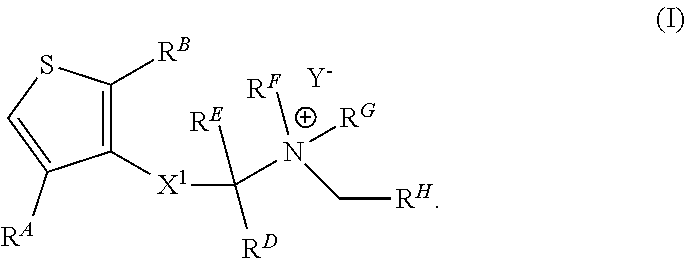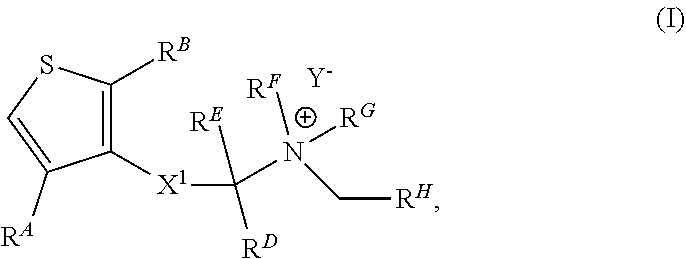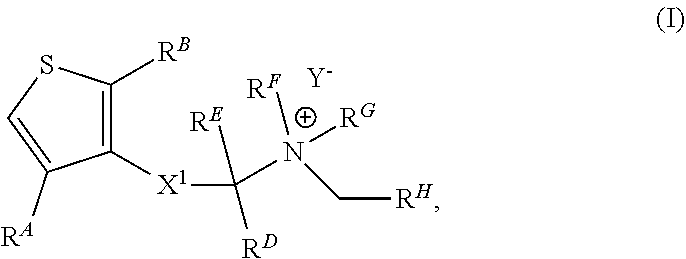Charged ion channel blockers and methods for use
a technology of ion channel blockers and ion channels, applied in the direction of heterocyclic compound active ingredients, organic chemistry, drug compositions, etc., can solve the problems of non-productive dry cough, inappropriate cough reflexes, and unproductive local anesthetic administration
- Summary
- Abstract
- Description
- Claims
- Application Information
AI Technical Summary
Benefits of technology
Problems solved by technology
Method used
Image
Examples
example 1
Syntheses
General Abbreviation Definitions
[0193]ACN acetonitrile
aq. aqueous
° C. degrees Celsius
δ chemical shift (ppm)
DCM dichloromethane
DMSO dimethyl sulfoxide
Et2O diethyl ether
EtOAc ethyl acetate
h hour
MeOH methanol
mHz megahertz
min min
ml milliliter
MS mass spectrometry
m / z mass to charge ratio
NMR nuclear magnetic resonance
UV ultraviolet light
Synthesis of 1-benzyl-1-(2-((2-(methoxycarbonyl)-4-methylthiophen-3-yl)amino)-2-oxoethyl)azepan-1-ium bromide
[0194]
Synthesis of intermediate methyl 3-(2-bromoacetamido)-4-methylthiophene-2-carboxylate
[0195]A stirred suspension of methyl 3-amino-4-methylthiophene-2-carboxylate (5 g, 29.20 mmol) in water (50.0 mL) was cooled to 0° C. and 2-bromoacetyl bromide (12 mL, 137.74 mmol) was added drop wise. The resulting mixture was allowed to stir at RT for 16 h as progress of the reaction was monitored by TLC (10% EtOAc in petroleum ether, visualization by UV). The reaction mixture...
example 2
n of Nav1.7 Current
[0200]Representative compounds of the invention were synthesized according to the described methods and tested for the ability to inhibit voltage-gated sodium channels.
Cell Culture
[0201]NaV1.7 was expressed upon induction with tetracycline. Cells were cultured in DVEM containing 10% dialyzed Fetal Bovine Serum (VWR, Radnor, Pa.),1% Glutamax (VWR, Radnor, Pa.), 1% Penicillin-Streptomycin (VWR, Radnor, Pa.), 100 mg / L Hygromycin (Thermo Fisher Scientific, Waltham, Mass. and 5 mg / L Blasticidin (Alfa Aesar, Haverhill, Mass.). Cells were grown and maintained at 37° C. in a humidified environment containing 10% CO2 in air. Cells were detached from the culture flask for passage and harvested using 0.05% Trypsin-EDTA (Thermo Fisher Scientific, Waltham, Mass.). To induce NaV1.7, cells were induced with tetracycline (0.1-1 μg / mL, IBI Scientific, Peosta, Iowa) the day before recording and plated onto 24-well plates. Cells were washed with DPBS (VWR, Radnor, Pa.), trypsinized ...
example 3
Permeability
[0213]The PAMPA assay (pION, Inc., Woburn Mass.) was used to determine the ability of compounds of the invention to cross an artificial lipid membrane by passive diffusion. Test compounds were dissolved in DMSO (10 mM) and diluted 200-fold in buffer (pION Inc., pH 7.4) to provide 50 uM stock solutions. Buffer (150 μL) was added to a UV blank plate and stock solutions (150 μL) were transferred to a UV reference plate. The blank and reference spectrum were read using a spectrophotometer. Stock solutions (200 μL) were added to the donor plate of the PAMPA sandwich plate and an accept plate painted with GIT lipid (pION Inc, 5 μL) was placed on top. Buffer (200 μL) was added to the acceptor plate and the PAMPA sandwich plate was incubated for 4 hours. Aliquots (150 μL) from the acceptor plate were added to a UV plate and read as acceptor spectrum. Aliquots (150 μL) of the donor solutions were added to a UV analysis plate and read as donor spectrum. The permeability coefficien...
PUM
| Property | Measurement | Unit |
|---|---|---|
| enantiomeric excess | aaaaa | aaaaa |
| enantiomeric excess | aaaaa | aaaaa |
| enantiomeric excess | aaaaa | aaaaa |
Abstract
Description
Claims
Application Information
 Login to View More
Login to View More - R&D
- Intellectual Property
- Life Sciences
- Materials
- Tech Scout
- Unparalleled Data Quality
- Higher Quality Content
- 60% Fewer Hallucinations
Browse by: Latest US Patents, China's latest patents, Technical Efficacy Thesaurus, Application Domain, Technology Topic, Popular Technical Reports.
© 2025 PatSnap. All rights reserved.Legal|Privacy policy|Modern Slavery Act Transparency Statement|Sitemap|About US| Contact US: help@patsnap.com



